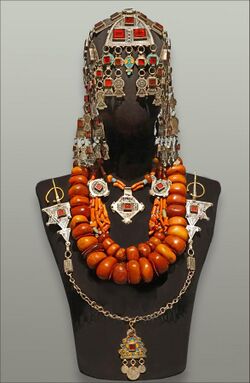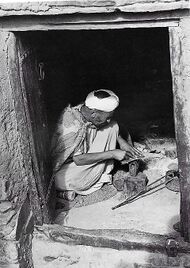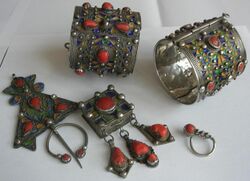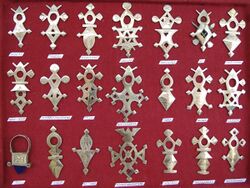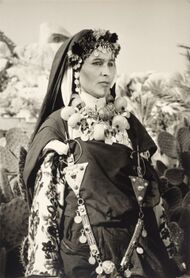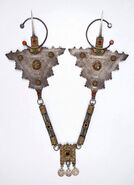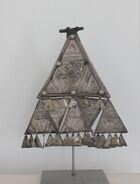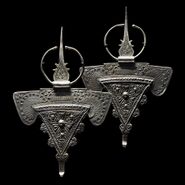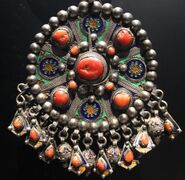Engineering:Jewellery of the Berber cultures
Jewellery of the Berber cultures (Tamazight language: iqchochne imazighne, ⵉⵇⵇⵛⵓⵛⵏ ⵉⵎⴰⵣⵉⵖⵏ) is a historical style of traditional jewellery that was worn by women mainly in rural areas of the Maghreb region in North Africa and inhabited by indigenous Berber people (in the Berber language Tamazight: Amazigh (sg.), Imazighen, pl). Following long social and cultural traditions, Berber or other silversmiths in Morocco, Algeria and neighbouring countries created intricate jewellery with distinct regional variations. In many towns and cities, there were Jewish silversmiths, who produced both jewellery in specific Berber styles as well as in other styles, adapting to changing techniques and artistic innovations.[1]
Handing their jewellery on from generation to generation, as a visual element of the Berber ethnic identity, women maintained this characteristic cultural tradition as part of their gender-specific adornments. As Berber communities have been most numerous in Morocco, compared with Algeria and even smaller communities in Tunisia or other geographic locations, the numbers and varieties of their ethnic jewellery correspond to these demographic patterns.[2]
Berber jewellery was usually made of silver and includes elaborate triangular plates and pins, originally used as clasps for garments, necklaces, bracelets, earrings and similar items. During the second part of the 20th century, the tradition of Berber jewellery was gradually abandoned in favour of different styles of jewellery made of gold. Just as other items of traditional rural life like carpets, costumes or ceramics, Berber jewellery has entered private and public collections of North African artefacts.[3] Contemporary variations of these types of jewellery like the symbol of a hand (Arabic: hamsa or in Maghrebi Arabic khmissa) are sold today as commercial fashion products.[4]
History
In their documented history, going back to prehistoric times,[5] the different indigenous Berber peoples of North Africa, ranging from the Siwa Oasis in Egypt to Morocco and Mauritania, have undergone constant changes in lifestyles and culture. Most notably, the Arab conquest brought about important changes from the late 7th century onwards. Over time, the different Berber groups of the vast area that is North Africa adapted to external influences and their cultures, living partially as rural, but also as urban populations. Especially in larger cities and towns, such as Marrakesh or Meknes, Berbers mixed with people of other ethnic backgrounds, gradually bringing forth an urban, Islamized and partially Arabized society, which led to a gradual change of traditional Berber culture.[6]
Rural Berber cultures
In rural areas, Berbers were traditionally farmers, living in mountains, plains or an oasis, such as the Siwa oasis in Egypt; but others, like the Tuareg and Zenata of the southern Sahara, were almost wholly nomadic. Some groups, such as the Chaouis, practised a semi-nomadic life (transhumance) and, during some months of the year, roamed the country with their herds of livestock (donkeys, sheep, goats, and camels in some areas) in search of fertile pastures.[6]
While sedentary life had flourished since prehistorical times, survival in the drier regions, and especially in the High Atlas and Anti-Atlas mountains, was only possible if people moved with their cattle to the higher mountain regions, where grass, herbs and above all water were still available in sufficient quantity. As they did not return to their villages until late autumn, their winter harvests were stored in a fortified communal granary, called agadir, and protected against other nomads and hostile neighbouring villages by guards, who stayed there at all times. In villages and small towns of Morocco, people often lived in traditional buildings called ksour (pl.).[7] In most settlements, blacksmiths and silversmiths operated small, family-run workshops.[8] Based on their skills of handling the four elements: fire, air, water and metals, originally taken from the earth, these professions were often not highly regarded, which was partly due to superstitious beliefs attributed to these skills.[9]
Berber jewellery in Morocco, Algeria and Tunisia
Jewellery is easy to transport, and the women could take it along on the annual migrations. In a traditional world that functioned completely or largely without money, jewellery also played a role as a means of savings for emergency situations. Thus, official coins were often used to adorn headgear, necklaces, etc. When necessary, they could be broken off and sold, but their value only consisted in the pure material value.[10]
While the Arabized and urban inhabitants of North Africa preferred jewellery made of gold, the rural Berbers held on to silver jewellery for centuries. This provided the economic basis for the silversmiths in medium-sized towns, such as Tiznit or Sefrou in Morocco or in the Kabylia mountains in Algeria, which were often run by Jewish silversmiths. Whether the preference for silver happened solely for social, economic or reasons attributed to folklore, such as the belief that these pieces bestow a protective effect (baraka),[11] or for other reasons, can no longer be determined.[12]
In Algeria, important centres of jewellery production and usage were the villages of the Beni Yenni district and the town of Ouadhiya in the Great Kabylia mountains east of Algiers. In the north-eastern mountain region of the Aurès, the Chaoui Berbers used silver jewellery, typically made with enamel applications and corals.[13] In southern Tunisia, the island of Djerba was a traditional centre of jewellery production, whereby figurative motifs (plants, fish, birds), and sometimes gold instead of silver were used in contrast to the traditions in Morocco and Algeria.[14][15]
Tuareg and Mauritanian jewellery
Jewellery made of silver, coloured glass or iron is also a special tradition of the Tuareg people.[16][17] They belong to the Berber peoples and mostly still live as semi-nomads in parts of the Sahara in the Hoggar region of modern-day Algeria, Libya, Niger, Mali and Burkina Faso. Their jewellery is remarkable for the so-called Cross of Agadez, even though only few of these pieces actually resemble a cross. Most are worn as pendants with varied shapes that either resemble a cross or have the shape of a plate or shield. Historically, the oldest known specimens were made of stone or copper, but subsequently the Tuareg blacksmiths also used iron and silver made in the lost-wax casting technique. According to the article "The cross of Agadez", this piece has become a national and African symbol for Tuareg culture and political rights.[18] Today, these pieces of jewellery are often made for tourists or as items of ethnic-style fashion for customers in other countries, with certain modern changes.[19]
Tuareg jewellery has been compared to similar styles of southwestern Morocco, the western parts of the Sahara and Mauritania, like the Cross of Trarza, traditionally produced by Berber people, who speak Hassaniya Arabic and are sometimes referred to as Moors or Beidane.[20] According to studies of Tuareg and Mauritanian jewellery, the latter are usually more embellished and may carry typical pyramidal elements.[21] Specimens of their jewellery, including heavy silver anklets, were published in the book Berber women of Morocco.[22]
Methods, forms and society
Traditional Berber jewellery consists mainly of silver, cast in a mould and afterwards finished by hand.[23][24] Depending on the region as well as the type of jewellery, enamelling, corals, beads of amber[25] and coloured glass or rarely semi-precious stones were applied. According to art historians, the art of enamelling using the cloisonné technique was introduced by Sephardi Jewish goldsmiths, who in turn had inherited this skill from their forefathers in Moorish Al-Andalus.[26][27] Another method used in the Maghreb is called filigrané, as thin silver filigree wire was used for intricate, mesh-like designs, to mark the boundaries of inserted beads or the areas for each colour of enamelled space in the typical shades of yellow, green and blue, before the melted glass powder was applied. Enamelled Berber jewellery was produced in Algeria (Great Kabylia), in Morocco (Tiznit and Anti-Atlas) as well as in Tunisia (Moknine and the island of Djerba).[28] Visible parts of the pieces that were not covered by enamelling or filigrané technique were mostly covered by engraved or chiselled designs hammered into the silver and often also made more visible by applying the niello technique.[29]
In addition to ornamental bracelets, anklets, pendants, rings and chains for necklaces or headgear, characteristic fibula or penannular brooches, composed of a symmetrical pair of triangular plates with pins, called tizerzaï, were used in a practical way with the pins perforating the women's unsown outer garments and pointing straight up to keep draped garments in place. In some cases, these Amazigh brooches were rather large and heavy, as they had to hold up long pieces of textile, made of cotton or wool, and loosely draped around the body. A chain or beaded necklace often was attached to the two brooches, fixed to a ring at the bottom of the brooches. As brooches in similar form and function are known from the Bronze Age and later Roman and Visigoth brooches,[30] such fibulae are believed to have been in use in the Maghreb since ancient times.[31][32][33]
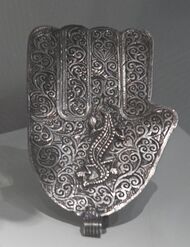
Typical basic forms of jewellery are triangles and almond shapes, as well as the so-called khmissa (local pronunciation of the Arabic word khamsa for the number five), which is called afus in Berber language (Tamazight). This form represents the five fingers of the hand and is traditionally believed both by Muslims as well as Jewish people to protect against the Evil Eye.[12] Apart from these, geometrical, floral, animal and "cosmic" forms such as solar discs or crescents were used according to regional traditions.[34][35] The geometric shapes of jewellery can also be found in the ornaments of Berber mud-brick or stone buildings and on their traditional clothes and carpets. The tattoos of Berber women and their henna ornaments applied on special occasions as well as some images of regional rock art also show similar forms.[12]
In the southern parts of Morocco, especially in today's regions of Drâa-Tafilalet and Sous with the important marketplace Tiznit, Jewish Berbers, who had lived there since at least the second century BCE until their emigration in the late 1950s,[36] were renowned silversmiths for their Berber jewellery. Since the khmisa,[37] as the "Hand of Miriam" also has a protective reputation against bad luck for Jews, such pieces were also made with a Star of David.[38][39]
Pieces of jewellery were valued objects and worn for important celebrations, such as weddings, religious and social gatherings like country fairs (moussem). They constituted the most important part of a husband's wedding gifts and a woman's dowry, that remained her personal property even in case of a divorce, and were passed on from one generation to the next.[40] Due to changes in generations, taste and wealth, they were often changed and reworked. Therefore, the age of many pieces is difficult to date, and one has to assume that most of them were only made in the late 19th and early 20th centuries.[12][41] Just as other elements of a person's appearance, jewellery was not only worn for aesthetic purposes, but also carried information about the social situation of women, including messages about marital status, wealth and social hierarchy.[42]
Modern changes
In the second half of the 20th century, the traditional lifestyles of the rural Berbers underwent important changes. Notwithstanding the constant modernization in the rural regions of the Maghreb, migration from the countryside to the cities and to other countries has been increasing steadily. Berber jewellery thus lost its original meaning, and demand as well as traditional production came to a standstill.[43][44] Art historian Cynthia Becker reports from her field studies in rural areas of southern Morocco during the 1990s that merely few Berber women still wore silver jewellery on a daily basis, and that traditional dress and jewellery were only worn during wedding ceremonies, where these traditions have played an important role before.[45][46]
According to most authors, however, contemporary Berber women have abandoned the use of traditional jewellery in favour of modern urban styles made of gold. Many pieces were sold to individual buyers travelling the area, and these in turn sold it on to the increasing number of antique and tourist shops in the cities.[47] Today, most customers are tourists or collectors from abroad,[48] while in contemporary art, Berber jewellery is used to "express a nostalgic and idealized vision of the past".[49]
In the early 2000s, Moroccan visual artist Amina Agueznay used historical silver pieces of the Berber tradition with her own additions to create her contemporary jewellery, such as a silver pendant and necklace with a traditional engraving on one side and a modern application on the other.[50]
Museum collections and exhibitions
As part of material cultural heritage, historical Berber jewellery has been collected by ethnographic museums in the Maghreb, such as the Dar Si Said museum in Marrakesh, the Musée du Patrimoine Amazigh[51] in Agadir or the Bardo National Museum in Algiers.[13] Museums in other countries, such as the Musée du quai Branly[52] in Paris, the Tropenmuseum in Amsterdam or the Metropolitan Museum of Art[53] and Brooklyn Museum[54] in New York City, also present such pieces and other traditional cultural objects of the Berber people.[55]
In 2008, the Museum for African Art in New York opened an exhibition of Moroccan jewellery and art from the private Xavier Guerrand-Hermès collection.[56] From December 2004 to August 2006, the Peabody Museum of Archeology and Ethnology at Harvard University presented the exhibition Imazighen! Beauty and Artisanship in Berber Life with an accompanying catalogue on traditional artifacts, including jewellery, from the Berber regions Kabylia in north-eastern Algeria, the Rif mountains of north-eastern Morocco and the Tuareg regions of the Algerian Sahara.[57][58]
The exhibition Splendeurs du Maroc at the Royal Museum for Central Africa in Belgium in 1998/99 presented a large variety of Moroccan jewellery from the museum's as well as private collections, described in the accompanying book of the same name.[59]
Art historian Björn Dahlström, a former director of the Berber Art Museum in Marrakesh,[60] edited the volume Berber women of Morocco, which was published in conjunction with the 2014/15 exhibition of the same name and shown in Paris, Manama and Rabat.[61][62] From February 2016 to January 2017, the Institut du Monde arabe in Paris exhibited more than 250 pieces of mainly Berber jewellery from Morocco, Algeria and Tunisia from a private collection, titled Des trésors à porter. Bijoux et parures du Maghreb [Treasures to wear. Jewellery and ornaments of the Maghreb]. The accompanying book includes images and information about the materials, techniques and regional origin of the different styles and pieces.[63]
Opened in January 2023, the National Jewellery Museum in Rabat presents a large and varied collection of Berber jewellery, alongside other Moroccan jewellery and personal adornment.[64]
- Selected pieces in museum collections
Fibula brooches of the bélier style, resembling a ram's head, in the Musée du quai Branly, Paris
Scholarship

Ethnographic studies in the Maghreb started with French colonial officials and social scientists and included descriptions of the Berber cultures, mostly with regard to their traditional architecture, textiles and ceramics, as well as to important social events like marriages, local festivals (moussems) and indigenous forms of economic life.[49]
During the second part of the 20th century, French ethnologists published academic papers and books for a wider public. These mainly focused on the classification of Berber jewellery in terms of category as brooches, earrings, bracelets etc., of materials, forms and local names of the different pieces and on the historical, geographical and ethnic origins of the silversmiths and their customers.[2] Since the beginning of the 21st century, art historians have widened their focus of investigation on further aspects of this cultural tradition, such as the social and gender-specific roles of Berber women and the changing importance of jewellery and other forms of Berber artistic production in the contemporary world.[66][67][16]
Early ethnographic descriptions
The French collector and art critic Paul Eudel (in French) (1837-1911) was one of the first authors of art historical descriptions of jewellery in the Maghreb. After his first account of jewellery in Algeria and Tunisia L'orfévrerie algérienne et tunisienne (1902),[68] he published a thematic dictionary with an even wider geographical scope, titled Dictionnaire des bijoux de l’Afrique du Nord. Maroc, Algérie, Tunisie, Tripolitaine (1906).[65] Based on his travels to these countries, he compiled detailed information about Berber and other styles of jewellery with graphic illustrations for his notes.[69]
Jean Besancenot (1902-1992), a French painter, self-trained ethnographer and documentary photographer, produced detailed descriptions as well as numerous photographs and artistic illustrations of traditional costumes and other forms of personal adornment in Morocco.[70] Commissioned by the administration of the French protectorate, he had collected these ethnographic records during his extensive travels in the country between 1934 and 1939.[71]
For his illustrated book Costumes du Maroc (1942), he identified three basic categories of costumes: rural Berber dress, Jewish dress and urban citizens' costumes, some of which with Arab elements of dress. Further, each of the portraits of his 60 gouache paintings was attributed to a specific social role (married woman, palace guard, musician etc.), city or region, and Berber dress also assigned to corresponding tribal groups. As these forms of dress were still very much alive and differentiated in the 1930s, Besancenot remarked that in rural areas, each type of dress represented a tribal identity.[72] As his artistic colour portraits of persons in full length did not allow sufficient space for elements like hair styles, shoes or how to drape loose pieces of textiles, such as the urban haik and Berber draped garments, he added explanations and drawings of these pieces of personal appearance. In order to represent jewellery in detail, he added descriptions and drawings of 56 pieces of urban as well as of 38 rural Berber styles.[73] In his second work, Bijoux arabes et berbères du Maroc (1953), he published his drawings and descriptions of almost 200 pieces of jewellery from different places and traditions in Morocco.[74] Besancenot originally was a painter, and his drawings highlight the intricate features of the pieces in reduced detail compared to his corresponding photographs.[75]
In the course of his field visits, he had learned to use photography as a means of quickly capturing his ethnographic impressions. In an interview with the journalist Dominique Carré, he commented on his approach: "I wanted to prove that scientists very often pursue their investigations in a frame of mind that partially leaves aside the aesthetic aspect. [...] They thoroughly study a number of things, but often neglect the aspects of traditional arts that contain a very important aesthetic value. I wanted to restore this value."[76]
Studies by ethnologists
Henriette Camps-Fabrer (1928-2015), a French ethnologist specialized in North African culture, wrote several books about the Berber jewellery of Algeria and the neighbouring Maghreb countries between the 1970s and 1990. She and her husband, Gabriel Camps (1927-2002) had grown up in colonial Algeria and published research on the history of the Berber people. After the independence of Algeria in 1962, they taught archaeology and cultural anthropology at the University of Algiers and were associated with the Bardo National Museum. Gabriel Camps was also the founder and first editor-in-chief of the Encyclopédie Berbère,[77] where entries about Berber jewellery, its history, production and typology by Camps-Fabrer were published.[8]
The French ethnologist Marie-Rose Rabaté is the (co-)author of several books and articles since the late 1970s about popular traditions in Morocco, focussing on costumes, jewellery and other decorative arts. Commenting on the disappearing use of Berber jewellery since the 1960s, she deemed it "urgent, at the end of the [20th] century, to identify these ornaments, to locate them as exactly as possible, in order to give them their rightful place in the history of Moroccan traditions."[78]
In his 1989 book Bijoux berbères au Maroc dans la tradition judéo-arabe,[79] that focussed on the Jewish tradition in Morocco, the ethnologist David Rouach[80] gave detailed information about how to ascertain the production date of some of the silver pieces, the forms and techniques used and especially about their symbols and designs.[81]
Studies by art historians
The 2021 book Berber Memories. Women and Jewellery in Morocco presents chapters by Belgian art historian Michel Draguet on the history of the Berbers, as well as on gender-specific cultural traditions of Berber women. Jewellery is set in the context of daily life, where women had a specific social status reflected by their handicrafts, oral poetry and fashion, including jewellery.[82] Drawing on a private collection of about 300 pieces, this volume of almost 600 pages also presents numerous photographs of Berber jewellery from different regions in Morocco.[83]
According to the article Deconstructing the history of Berber arts: tribalism, matriarchy and a primitive Neolithic past (2010) by Boston University's African art historian Cynthia Becker,[84] the contemporary understanding of the history of Berber artistic traditions remains cursory and superficial. While postcolonial scholarship has critically exposed the stereotypes and Eurocentric approach of earlier studies, she posits that this historical approach has been insufficient to understand the complex realities of North African people's lives. In particular, she claims that the influence of Islam, Arab culture, trade and migration have largely been overlooked. Further, she challenged the notion of "urban Arab" artistic production as opposed to "rural Berber" artefacts and quoted art historian Sidney L. Kasfir's article One tribe, one style?, which states that "pre-colonial cultures were mutually dependent, interacted frequently, and shared many of their artistic traditions across ethnic boundaries."[85] Criticizing the notion of "ancient" Berber traditions that denies historical change, Becker argues: "Such claims romanticize and de-historicize rural Berbers, reinforcing the idea that authentic Berber arts are those that remained untouched throughout the centuries."[86] Referring to interpretations of Berber motifs as archetypal forms with protective features that have been traced to pre-Islamic times by colonial-era ethnologists such as Gabriel Camps,[87] Becker further cautions that the notion of an "unconscious, millennia-old “Berberness” fails "to consider subtle social encounters and negotiations that influence artistic production."[88]
Commenting on the central and gender-specific roles of women as producers of clothing and textiles and as beneficiaries of costumes and jewellery, Becker wrote in her 2006 study, Amazigh Arts in Morocco. Women Shaping Berber Identity,: "Women both created the artistic symbols of Berber identity and wore them on their bodies, making the decorated female body a public symbol of Berber identity."[66] In she concludes that in contrast to North Africans of Arab culture, Berber women "are the primary producers of art, and women's arts identify the group as Berber."[89]
French ethnologist Marie-Luce Gélard discusses jewellery in the context of collective marriage rituals of the Aït Khabbash tribe in southeastern Morocco, and emphasizes both the gender-specific nature of such objects as well as the complementarity of gender-related cultural practices as follows:[67]
Jewellery has a gender, of course [...] Actually, by their social and ritual use, these pieces of jewellery go beyond the sole manifestation of the feminine sphere. If they represent the wife, they are also the expression of the meeting, the union and the complementarity of the genders. [...] We are far from the normative visions of totally disjoint masculine and feminine universes; the ritual use and display of objects rather testifies to a unity of the genders.
Other contemporary aspects of ethnographic studies and the presentation of Berber and other North African material culture in museums relate to questions, how the complex social history and cultural production of Berber or Arabic-speaking people may be understood. In the context of post-colonial studies, authors such as Cynthia Becker and Lisa Bernaseck have stated that the relationships between "individuals, state institutions, academic scholarship and colonial arts policies have shaped our understanding of Berber arts". Art historical categories used to explain these relationships, such as the distinction between Arab/urban versus Berber/rural or ethnographical versus artistic objects, "continue to organize the production of knowledge about these arts today" and still are considered not fully adequate to describe the complex social production and interpretation of changing societies in the Maghreb.[90]
See also
- Berber culture
- Berber carpet
- National Jewellery Museum (Morocco)
Notes and references
- ↑ Jonathan Bloom, Sheila S. Blair, Sheila Blair (2009). Grove Encyclopedia of Islamic Art & Architecture: Three-Volume Set. New York: Oxford University Press USA. pp. 378. ISBN 978-0-19-530991-1. https://books.google.com/books?id=un4WcfEASZwC&pg=PA358.
- ↑ 2.0 2.1 See, for example, Rabaté 2015 and Rabaté, Rabaté & Champault 1996, as well as Gargouri-Sethom 1986.
- ↑ Already in the 1950s, at the end of his introduction to Bijoux arabes et berbères du Maroc, ethnographer Jean Besancenot deplored that with some few exceptions in southern Morocco, the production of traditional jewellery had been "abandoned or bastardized to the point of no longer being recognizable, as light-weight and quickly made modern pieces were being favoured by local customers". Besancenot 1953, pp. XIII-XVI
- ↑ Rabaté, Goldenberg & Thau 1999, pp. 131-132.
- ↑ J. Desanges 1990, "The proto-Berbers" in General History of Africa, vol. II: Ancient Civilizations of Africa. Paris: UNESCO, pp. 236–245, especially p. 237.
- ↑ 6.0 6.1 "Berber. Definition, People, Languages, & Facts Britannica". https://www.britannica.com/topic/Berber.
- ↑ See the reused link for the Encyclopedia britannica on Berbers: "The economy was largely subsistence agriculture and pastoralism practiced by farmers, transhumants, and nomads, coupled with weaving, pottery, metalwork, and leatherwork, and local and some long-distance trade. Dwellings varied from caves to pitched-roof houses to flat-roofed “castles” to tents."
- ↑ 8.0 8.1 Camps-Fabrer, Henriette (1991-12-01). "Bijoux - Le bijoutier et ses outils" (in fr). Encyclopédie berbère (10): 1496–1516. doi:10.4000/encyclopedieberbere.1758. ISSN 1015-7344. https://journals.openedition.org/encyclopedieberbere/1758#tocfrom1n1.
- ↑ Agabi, C.; Hincker, C. (1998-02-01). "Forgerons" (in fr). Encyclopédie berbère (19): 2889–2897. doi:10.4000/encyclopedieberbere.1955. ISSN 1015-7344. https://journals.openedition.org/encyclopedieberbere/1955.
- ↑ Rabaté, Goldenberg & Thau 1999, p. 170.
- ↑ On traditions of protective jewellery of the Tuareg people, see Seligman and Loughran 2006, Does it have to be beautiful to empower? pp. 194-201
- ↑ 12.0 12.1 12.2 12.3 Camps-Fabrer, Henriette (1973). "L'origine des fibules berbères d' Afrique du Nord". Revue des mondes musulmans et de la Méditerranée 13 (1): 217–230. doi:10.3406/remmm.1973.1205. https://www.persee.fr/doc/remmm_0035-1474_1973_num_13_1_1205.
- ↑ 13.0 13.1 Camps-Fabrer 1970
- ↑ Gargouri-Sethom 1986, p. 97-102.
- ↑ Ethnologists and art historians have not commented on these kinds of jewellery or aesthetic patterns as relating to Islamic art, but rather with reference to older Mediterranean traditions.
- ↑ 16.0 16.1 Loughran 2006, pp. 167–212
- ↑ Dieterlen, Germaine; Ligers, Ziedonis (1972). "Contribution à l'étude des bijoux touareg". Journal des Africanistes 42 (1): 29–53. doi:10.3406/jafr.1972.1697. https://www.persee.fr/doc/jafr_0037-9166_1972_num_42_1_1697.
- ↑ Seligman and Loughran (2006), The cross of Agadez as a national and political symbol, pp. 258- 261
- ↑ Seligman and Loughran (2006), The cross of Agadez, pp. 251-265
- ↑ Taine-Cheikh, C. (2010-12-30). "Maures contemporains" (in fr). Encyclopédie berbère (31): 4716–4717. doi:10.4000/encyclopedieberbere.518. ISSN 1015-7344. https://journals.openedition.org/encyclopedieberbere/518.
- ↑ Liu, Robert K. (2018). "Tuareg amulets and crosses: Saharan/Sahelian innovation and aesthetics". Ornament 40 (3): 58–63. https://www.ornamentmagazine.org/articles/tuareg-jewelry-413.
- ↑ Becker 2014, pp. 75, 94
- ↑ See the section "Techniques du feu" (Technical aspects working with fire) in Camps-Fabrer 1991, Bijoux, in the online Encyclopédie Berbère or Camps-Fabrer 1990, pp. 27–51 Outils et techniques
- ↑ According to Camps-Fabrer, "Silver was the only precious metal used by Berber goldsmiths. It is not the same in Aurès, where the appearance of gold jewelry among a few wealthy women dates back to 1962-1963." Translated from the French original at Camps-Fabrer, H. (1989-01-01). "Argent (lfeṭṭa)" (in fr). Encyclopédie berbère (6): 881–882. doi:10.4000/encyclopedieberbere.2587. ISSN 1015-7344. https://journals.openedition.org/encyclopedieberbere/2587.
- ↑ Becker 2009, p. 118: "Beginning with the Phoenicians, amber from the Baltic regions of Eastern Europe has been traded all over the Mediterranean world for centuries."
- ↑ Camps-Fabrer 1990, pp. 121–122 and Rabaté, Goldenberg & Thau 1999, pp. 207–209
- ↑ Commenting on the origins of enamelled Berber jewellery, Camps-Fabrer wrote: "The great originality of jewels from the Great Kabylia as well as those from Moknine in Tunisia or the Moroccan Anti-Atlas mountains comes from the presence of coloured enamels. This technique, originally urban, seems to be attributable to a foreign influence. The enamelled goldsmithery known in the Vandal and Byzantine era would have completely disappeared from the Mediterranean countries, if North Africa had not, at the dawn of modern times, served as a refuge for Jewish, Andalusian and Morisco craftsmen driven out of Spain, where this technique was maintained throughout the Middle Ages. See Camps-Fabrer, H. (1991-12-01). "Bijoux - L'origine de l'orfèvrerie berbère" (in fr). Encyclopédie berbère (10): 1496–1516. doi:10.4000/encyclopedieberbere.1758. ISSN 1015-7344. https://journals.openedition.org/encyclopedieberbere/1758#tocto1n7.
- ↑ Camps-Fabrer, H. (1996-08-01). "Émail" (in fr). Encyclopédie berbère (17): 2611–2614. doi:10.4000/encyclopedieberbere.2139. ISSN 1015-7344. https://journals.openedition.org/encyclopedieberbere/2139.
- ↑ Rabaté, Goldenberg & Thau 1999, p. 30.
- ↑ "Eagle Fibula" (in en). https://art.thewalters.org/detail/16373/eagle-fibula-3/.
- ↑ Victoria and Albert Museum. "Penannular Brooch | Unknown | V&A Explore The Collections" (in en). https://collections.vam.ac.uk/item/O79372/.
- ↑ In her article about the history and usage of fibulae, Camps-Fabrer (1997) mentions the oldest known specimens of fibulae in the Maghreb: "However, from the Bronze Age, two types of fibulae appeared. The first is represented by a bow fibula which comes from the Beni Messous dolmen, unfortunately lost but described by Doctor Bertherand. The second type also found in Beni Messous is an omega fibula which is kept at the Bardo Museum in Algiers: it is an open ring whose ends are reinforced by polyhedra; a barb movable along the ring is made of a narrow sheet of bronze, one end of which is wrapped around the ring, the other ending in a point." Translated from the French original at Camps-Fabrer, H. (1997-08-01). "Fibule" (in fr). Encyclopédie berbère (18): 2817–2825. doi:10.4000/encyclopedieberbere.2050. ISSN 1015-7344. https://journals.openedition.org/encyclopedieberbere/2050.
- ↑ Rabaté, Marie-Rose. 2013. Les fibules: deux mille ans en Afrique du Nord; arts et symboles. Paris: ACR éd.
- ↑ Gargouri-Sethom 1986, p. 83-108.
- ↑ Ethnologists and art historians have not commented on these kinds of jewellery as Islamic art, but rather related them to ancient Mediterranean aesthetic traditions. See the bibliography at the end of the entry Bijoux (Jewellery) at https://journals.openedition.org/encyclopedieberbere/1758#tocto1n7
- ↑ Zafrani 2010, pp. 23, 29–30 and Patai, Raphael & Bar-Itzhak, Haya (eds.): Encyclopedia of Jewish Folklore and Traditions, p. 389. M.E. Sharpe, 2013
- ↑ Camps-Fabrer, H. (2010-12-29). "Main (Berb. : afus*, pl. ifassen; cf. EB II)" (in fr). Encyclopédie berbère (30): 4508–4518. doi:10.4000/encyclopedieberbere.415. ISSN 1015-7344. https://journals.openedition.org/encyclopedieberbere/415.
- ↑ See the section "Juifs et Berbères" in Draguet & de Merode 2020, pp. 66–79 as well as Rabaté, Goldenberg & Thau 1999, pp. 182–189
- ↑ On the theories and facts about Jewish Berbers, see Bruce Maddy Weitzman "Jews and Berbers". http://www.dayan.org/articles/JewsandBerbers.pdf.
- ↑ Laoust-Chantreaux, G.; Laoust, E.; Berque, J.; Gaudry, M.; E. B.; Claudot-Hawad, H. (1995-11-01). "Dot" (in fr). Encyclopédie berbère (16): 2512–2519. doi:10.4000/encyclopedieberbere.2204. ISSN 1015-7344. https://journals.openedition.org/encyclopedieberbere/2204.
- ↑ Rabaté, Goldenberg & Thau 1999, p. 37 included a photograph and the date of production in 1877 of an anklet from Fes.
- ↑ Becker 2014, p. 43.
- ↑ "Marché de l'argent: Les artisans bijoutiers s'éteignent doucement" (in fr). 2015-02-06. https://www.leconomiste.com/article/966242-marche-de-l-argent-les-artisans-bijoutiers-s-eteignent-doucement.
- ↑ In 1953, Jean Besancenot wrote that at the time "the craftsmen have lost all the traditional quality" and "The old patterns are abandoned or bastardized to the point of no longer being recognizable.Besancenot 2001, p. XIII
- ↑ Becker, Cynthia (2008). "Fadma Lhacen: healer of women and weaver of textiles (Moroccan Berber healer)". in Trix, Frances; Walbridge, John; Walbridge, Linda (in en). Muslim voices and lives in the contemporary world. New York: Palgrave Macmillan US. pp. 32. doi:10.1057/9780230611924_3. ISBN 978-0-230-61192-4. https://doi.org/10.1057/9780230611924_3. Retrieved 2022-02-06.
- ↑ Becker 2009, p. 187: [The bride] "typically wears the amber and silver jewelry (once worn by her mother and grandmother on a daily basis) during the wedding ceremony, although she may remove it on the third day to wear a European inspired white wedding gown."
- ↑ Becker 2009, p. 186: "In the last decade, most Amazigh women have sold the silver jewelry and the amber necklaces that their mothers and grandmothers wore to European collectors and tourist shops, preferring to wear gold jewelry."
- ↑ Rabaté, Rabaté & Champault 1996, pp. 8-9, 17.
- ↑ 49.0 49.1 Becker 2010, pp. 195–220
- ↑ Jansen, M. Angela (2014-11-20) (in en). Moroccan Fashion: Design, Culture and Tradition. Bloomsbury Publishing. pp. 48–49. ISBN 978-1-4725-8919-4. https://books.google.com/books?id=u83cBAAAQBAJ&dq=Amina+Agueznay&pg=PA48.
- ↑ "The Amazigh Heritage Museum: Sites & Monuments of Agadir". http://agadirmonuments.com/en/agadir-monuments-the-amazigh-heritage-museum/.
- ↑ Musée du Quai Branly. [=Bijoux%20berberes%7C2%7C "Bijoux berbères"]. https://www.quaibranly.fr/fr/explorer-les-collections/base/Work/action/list/?orderby=default&order=desc&category=oeuvres&tx_mqbcollection_explorer%5Bquery%5D%5Btype%5D=&tx_mqbcollection_explorer%5Bquery%5D%5Bclassification%5D=&tx_mqbcollection_explorer%5Bquery%5D%5Bexemplaire%5D=&filters[]=Bijoux%20berberes%7C2%7C.
- ↑ Stewart, Courtney A. (4 December 2017). "Remarkable Berber Jewelry at The Met". https://www.metmuseum.org/blogs/collection-insights/2017/berber-jewelry-morocco-algeria.
- ↑ "Fibula. Arts of the Islamic World". https://www.brooklynmuseum.org/opencollection/objects/197003.
- ↑ "Arab and Berber weavings from Morocco". https://www.brooklynmuseum.org/opencollection/exhibitions/1357.
- ↑ Becker, Cynthia and Kristyne Loughran, 2008. Desert jewels: North African jewelry and photography from the Xavier Guerrand-Hermès collection. New York: Museum for African Art.
- ↑ Becker, Cynthia (2010). "Artistry of the Everyday: Beauty and Craftsmanship in Berber Art Lisa Bernasek Susan G. Miller". The International Journal of African Historical Studies 43 (1): 200–202.
- ↑ Bernasek, Lisa (2008). Artistry of the everyday: beauty and craftsmanship in Berber art. Cambridge, Massachusetts: Peabody Museum Press, Harvard University. pp. 60–111. ISBN 978-0-87365-405-0. OCLC 182662537.
- ↑ Grammet 1998, pp. 212–339.
- ↑ "Musée Pierre Bergé des arts berbères – Jardin Majorelle". https://www.jardinmajorelle.com/musee-pierre-berge-des-arts-berberes/.
- ↑ Guerraoui, Saad (2015-07-03). "Berber Women of Morocco exhibition at Rabat National Library" (in en). http://thearabweekly.com/berber-women-morocco-exhibition-rabat-national-library.
- ↑ Dahlström, Björn. 2014. Berber women of Morocco; [... was publ. in conjunction with the exhibition "Berber Women of Morocco" held at the Fondation Pierre Bergé - Yves Saint Laurent, in Paris, from March 21 to July 20, 2014, at the Bahrain National Museum in Manama, from Jan. 15 to April 17, 2015 and at the Bibliothèque Nationale du Royaume du Maroc in Rabat, in the spring of 2015]. Paris: Fondation Pierre Bergé - Yves Saint Laurent.
- ↑ "Des trésors à porter" (in fr). 2016-03-24. https://www.imarabe.org/fr/expositions/des-tresors-a-porter.
- ↑ Firdaous, Kawtar (2023-01-12). "Rabat. Le musée national de la parure rouvre ses portes" (in FR). https://lobservateur.info/article/105033/culture/rabat-le-musee-national-de-la-parure-rouvre-ses-portes.
- ↑ 65.0 65.1 Eudel 1906.
- ↑ 66.0 66.1 Becker 2006, p. 1
- ↑ 67.0 67.1 Gélard 2012, pp. 89–104
- ↑ Eudel 1902.
- ↑ Eudel 1902, pp. V-XIII.
- ↑ E. B. (1995-11-01). "Djellaba" (in fr). Encyclopédie berbère (16): 2425–2427. doi:10.4000/encyclopedieberbere.2181. ISSN 1015-7344. https://journals.openedition.org/encyclopedieberbere/2181.
- ↑ "Jean Besancenot" (in fr). 2018-01-04. https://maisondelaphotographie.ma/2018/01/04/jean-besancenot/.
- ↑ Besancenot 1988, p. 9.
- ↑ Besancenot 1988, pp. 186-205.
- ↑ Besancenot 2001.
- ↑ Musée du quai Branly. "Photographs by Jean Besancenot". https://www.quaibranly.fr/fr/explorer-les-collections/base/Work/action/list/?orderby=default&order=desc&category=oeuvres&tx_mqbcollection_explorer%5Bquery%5D%5Btype%5D=&tx_mqbcollection_explorer%5Bquery%5D%5Bclassification%5D=&tx_mqbcollection_explorer%5Bquery%5D%5Bexemplaire%5D=&filters%5B%5D=Jean%20Besancenot%7C2%7C.
- ↑ Translated from the French original text: Dominique Carré (2020), Jean Besancenot, ethno-photographe et photo-ethnographe. In Hannah Assouline and Dominique Carré. Juifs du Maroc. Photographies de Jean Besancenot 1934-1937. Paris: Musée d'Art et d'Histoire du judaïsme, pp. 14-20
- ↑ Gast, Marceau; Bernus, Edmond; Desanges, Jehan; Chaker, Salem (2008-09-01). "Gabriel Camps" (in fr). https://journals.openedition.org/encyclopedieberbere/752.
- ↑ Rabaté, Goldenberg & Thau 1999, p. 11.
- ↑ [In English: Berber jewellery in Morocco in the Jewish-Arabic tradition]
- ↑ (in fr) Rouach, David. Bibliothèque nationale de France. https://catalogue.bnf.fr/ark:/12148/cb121158634.
- ↑ Rouach 1989, pp. 12–46.
- ↑ Draguet & de Merode 2020, pp. 90-93.
- ↑ Draguet & de Merode 2020.
- ↑ "Cynthia Becker | History of Art & Architecture" (in en). https://www.bu.edu/haa/profile/cynthia-becker/.
- ↑ Kasfir, Sidney Littlefield (1984). "One Tribe, One Style? Paradigms in the Historiography of African Art". History in Africa 11: 163–193. doi:10.2307/3171633. ISSN 0361-5413. https://www.jstor.org/stable/3171633.
- ↑ Becker 2010, p. 198 refers to the book Imazighen: the vanishing traditions of Berber women, where the author Geraldine Brooks claims "that Berbers live now as they have for centuries" and that a Berber weaver "draws on a repertoire of symbols that predates the Roman Empire".
- ↑ Gabriel Camps 1995 Les Berbères: mémoire et identité. Paris: Errances, p. 210
- ↑ Becker 2010, p. 105.
- ↑ Becker 2006, p. 1, notes that Berber women used to wear elaborate jewellery, tattoos and henna ornaments, and have created carpets and other textiles, ceramics and household artifacts.
- ↑ Bernaseck, Lisa (2010). ""First arts" of the Maghrib: exhibiting Berber culture at the Musée du quai Branly". in Hoffman, Katherine E. (in en). Berbers and others: Beyond tribe and nation in the Maghrib. Bloomington: Indiana University Press. p. 186. ISBN 978-0-253-35480-8. https://books.google.com/books?id=W-ziBn5HakEC&dq=berber+jewelry+modern&pg=PA195.
Sources
- Becker, Cynthia (2006). Amazigh arts in Morocco : women shaping Berber identity. Austin: University of Texas Press. ISBN 978-0-292-79591-4. OCLC 568018126. https://archive.org/download/AmazighArtsInMorocco/Cynthia%20J.%20Becke%20-%20Amazigh%20Arts%20in%20Morocco.pdf.
- Becker, Cynthia (2010). "Deconstructing the history of Berber arts: tribalism, matriarchy and a primitive Neolithic past". in Hoffman, Katherine E. (in en). Berbers and others: Beyond tribe and nation in the Maghrib. Bloomington: Indiana University Press. pp. 195–220. ISBN 978-0-253-35480-8. https://books.google.com/books?id=W-ziBn5HakEC&dq=berber+jewelry+modern&pg=PA195.
- Becker, Cynthia (2014). "Jewelry art. Masterpieces of Berber identity". in Dahlström, Björn. Berber women of Morocco. Paris: Éditions Artlys. pp. 43–75. ISBN 978-2-85495-576-7. OCLC 902727356.
- Besancenot, Jean (1988) [1942]. Costumes et types du Maroc illustrés de soixante gouaches reproduites en facsimile et en camaïeu. Paris: Horizons de France. ISBN 978-2-85744-357-5. https://books.google.com/books?id=Dm96WocgtIsC&dq=Jean+Besancenot+Morocco&pg=PA5.
- Besancenot, Jean (2001) [1953]. Bijoux arabes et berbères du Maroc: 40 planches comprenant 193 modèles de bijoux, dessinés et commentés. Casablanca: Editions de la Cigogne. ISBN 978-9954-0-2672-4.
- Camps-Fabrer, Henriette (1970). Les Bijoux de grande Kabylie. Algiers, Arts et métiers graphiques: Collections du Musée du Bardo et du Centre de recherches anthropologiques, préhistoriques et ethnographiques.
- Camps-Fabrer, Henriette (1990). Bijoux berbères d'Algérie: Grande Kabylie, Aurès. Aix-en-Provence: Édisud.
- Chakour, Djamila, et al. (2016). Des tresors a porter: Bijoux et parures du Maghreb: Collection J.-F. Et M.-L. Bouvier. Paris: Institut du monde arabe. ISBN:978-2-84306-184-4 OCLC 1005136135
- Berber memories: women and jewellery in Morocco through the Gillion Crowet Collections. Brussels: Mercatorfonds. 2020. ISBN 978-0-300-25395-5.
- Eudel, Paul (1902). L'orfévrerie algérienne et tunisienne. New edition 2014, Casablanca: Éditions Frontispice, ISBN:978-9954-612-20-0
- Eudel, Paul (1906). Dictionnaire des bijoux de l'Afrique du Nord. Maroc, Algérie, Tunisie, Tripolitaine. Paris: Leroux. https://gallica.bnf.fr/ark:/12148/bpt6k5738601g/f7.item.
- Gargouri-Sethom, Samira (1986) (in fr). Le bijou traditionnel en Tunisie: femmes parées, femmes enchaînées. La Calade, Aix-en-Provence: Edisud. ISBN 978-2-85744-269-1. OCLC 18290125.
- Gélard, Marie-Luce (2012). "Le rôle des objets dans les rituels de mariage collectifs (Sahara, Maroc)" (The role of objects in collective wedding rituals (Sahara, Morocco))" (in fr). Les objets ont-ils un genre? Culture matérielle et production sociale des identités sexuées. Paris: Armand Colin. pp. 89–104. ISBN 978-2-200-27713-0.
- Grammet, Ivo (1998). "Les Bijoux". in Grammet, Ivo. Splendeurs du Maroc. Tervuren: Musée royal de l'Afrique centrale. pp. 212–339. ISBN 90-75894-14-7.
- Loughran, Kristyne (2006). "Tuareg women and their jewelry". in Seligman, Thomas K.. Art of being Tuareg : Sahara nomads in a modern world. Los Angeles: Iris & B. Gerald Cantor Center for Visual Arts at Stanford University UCLA Fowler Museum of Cultural History. pp. 167–212. ISBN 978-0-9748729-4-0. OCLC 61859773.
- Rabaté, Marie-Rose (2015) (in fr). Les bijoux du Maroc : du Haut-Atlas à la vallée du Draa. Paris-La Défense: ACR édition. ISBN 978-2-86770-210-5. OCLC 932463823.
- Rabaté, Marie-Rose; Goldenberg, André; Thau, Jean-Louis (1999). Bijoux du Maroc du Haut Atlas à la Méditerranée, depuis le temps des juifs jusqu'à la fin du XXe siècle. Aix-en-Provence: Edisud/Eddif. ISBN 978-2-7449-0081-5. https://books.google.com/books?id=nMXAYZPXAKoC&dq=triangle&pg=PA207.
- Rabaté, Marie-Rose; Rabaté, Jacques; Champault, Dominique (1996). Bijoux du Maroc: du Haut Atlas à la vallée du Draa. Aix-en-Provence: Edisud/Le Fennec. ISBN 978-2-85744-864-8.
- Rouach, David (1989) (in fr). Bijoux berbères au Maroc dans la tradition judéo-arabe. Courbevoie, Paris: ACR. ISBN 978-2-86770-034-7. OCLC 21160206.
Further reading
- Benfoughal, Tatiana (1997). Bijoux et bijoutiers de l'Aurès, Algérie: traditions & innovations. Paris: CNRS Editions. ISBN 2-271-05446-X.
- Burner, Jean (2011) (in fr). Bijoux touaregs : art des bijoux anciens du Sahel et du Sahara au Niger. L'Argentière-la-Bess: Ed. du Fournel. ISBN 978-2-36142-024-6. OCLC 731902569.
- Courtney-Clarke, Margaret; Brooks, Geraldine (1996). Imazighen: the vanishing traditions of Berber women. New York: Clarkson N. Potter. ISBN 978-0-517-59771-2. OCLC 35698616.
- Dahlström, Björn, ed (2014). Berber women of Morocco. Paris: Éditions Artlys. ISBN 978-2-85495-576-7. OCLC 902727356.
- Grammet, Ivo (2011). "Jewellery from Southern Morocco". Arts & Cultures 12: 92–111. https://www.barbier-mueller.ch/wp-content/uploads/AC2011_Grammet_ENG.pdf.
- Musée national du Bardo (2011) (in fr). Les parures et bijoux algériens à travers l'histoire. https://www.mama-dz.com/media/files/publication/les-parures-et-bijoux-algeriens-a-travers-lhistoire.pdf.
- Rabaté, Marie-Rose; Goldenberg, André (2004) (in fr). Arts et cultures du Maroc : un jardin d'objets. Courbevoie, Paris: ACR. ISBN 978-2-86770-162-7. OCLC 55236670.
- Rabaté, Marie-Rose (2013) (in fr). Les fibules : deux mille ans en Afrique du Nord: arts et symboles. Paris-La Défense: ACR éditions. ISBN 978-2-86770-207-5. OCLC 866827622.
- Zafrani, Haïm (1998) (in fr). Deux mille ans de vie juive au Maroc : histoire et culture, religion et magie. Paris Casablanca: Maisonneuve & Larose Eddif. ISBN 9981-09-018-2. OCLC 41505905.
External links
- Collection of Berber jewellery at the Musée du quai Branly
- Berber jewelry at the Metropolitan Museum of Art
- Online database of the Smithsonian National Museum of African Art, Berber artists
- Comprehensive overview on Berber jewellery, with many images (in French) online at Encyclopédie berbère
- Description and pictures of the book Berber Memories. Women and Jewellery in Morocco (2021).
- Blog by Sigrid van Roode: Silver savings: of bracelets, banks and ladies who mean business
 |
